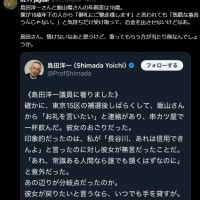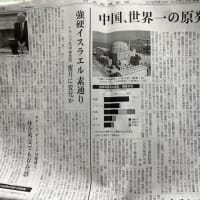Teaching the Chinese People That Their Nation Should Be a Maritime Power—and That China Is a Great Country Meant to Lead the World
October 29, 2021
The following is from the final column in the latest issue of Shukan Shincho, written by Yoshiko Sakurai.
This article, too, proves that she is a “National Treasure” in the highest sense as defined by Saichō.
Voters must read this essay before heading to the polls on October 31.
It is essential reading not only for the Japanese people, but for audiences around the world.
The Dangerous Trajectory Hidden in the “LDP–Communist Collaboration”
On October 25, Kazuo Shii, chairman of the Japanese Communist Party (JCP), appeared on BS Fuji’s Prime News, where he insisted that Japan should not respond to China by strengthening its military power, but instead resolve issues through dialogue.
He further argued that Japan’s defense budget should be cut by one trillion yen.
The Communist Party’s stance is utterly off base.
Mr. Shii must face reality.
When China seized a Philippine island in the South China Sea, the Philippines appealed to the Permanent Court of Arbitration.
The ruling fully upheld the Philippine claim, stating that China’s assertions of sovereignty over the South China Sea and the islands lacked any basis in international law or historical fact.
Nevertheless, China denounced the ruling as “waste paper” and has continued its barbaric acts in the region.
Thus, Mr. Shii’s claim that problems with such a China can be solved through discussion is meaningless.
To make matters worse, the JCP’s party platform calls for the dissolution of the Japan-U.S. Security Treaty and, in effect, the disbanding of the Self-Defense Forces.
Despite this, the JCP and the Constitutional Democratic Party of Japan (CDP) are reportedly coordinating to gain advantage in the general election.
Voters must not be deceived by Mr. Shii, the JCP, or the CDP.
On October 23, China’s Ministry of National Defense announced that ten Chinese and Russian naval vessels had conducted a joint maritime patrol from the 17th to the 23rd.
Japan’s Ministry of Defense Joint Staff Office also released photos of these ships’ movements.
They clearly show that the joint patrol was in fact a military show of force, circling Japan while conducting anti-submarine missile launches and helicopter landing exercises.
The Chinese and Russian fleets passed through the Tsugaru Strait on October 18.
On the 19th, they conducted anti-submarine missile drills off the Tōhoku coast.
On the 20th, they approached within 130 kilometers of Japanese territory off Cape Inubō, Chiba Prefecture.
On the 21st, shipborne helicopters landed and took off off the Izu Peninsula.
On the 22nd, they passed off the coast of Kōchi Prefecture and entered the East China Sea through the Ōsumi Strait, where a Chinese missile destroyer again conducted helicopter drills off the Danjō Islands, Nagasaki Prefecture.
Five ships from the PLA Navy, including the destroyer Nanchang, and five from the Russian Pacific Fleet, including the large anti-submarine ship Admiral Tributs, took part, along with six shipborne helicopters.
Before circling Japan, from the 14th to the 17th, they held joint exercises in the Sea of Japan off Vladivostok.
After separating from the Chinese, the Russian fleet entered the Sea of Japan through the Tsushima Strait and continued northward.
Their objective: to confront the United States and warn Japan by demonstrating military might.
The first large-scale China–Russia joint exercise took place in August sixteen years ago, in the Sea of Japan near Vladivostok.
This postwar-first drill involved 10,000 personnel.
The most notable segment was the three-day exercise on the Shandong Peninsula, where forces moved inland from the coast under air bombardment—clearly a mock landing operation envisioning Taiwan.
Precision-Guided Weapons Aimed at Japan
Another major joint exercise was “Vostok 2018” in September of that year.
With 300,000 troops, 36,000 military vehicles, 1,000 aircraft, and 80 warships, the exercise included forces from China and Mongolia.
The fact that Chinese troops conducted drills on Russian soil marked a significant development.
Moreover, as revealed by U.S. military expert Thomas Shugart, within China’s interior lie full-scale mock-ups of the U.S. bases in Kadena, Yokosuka, and Misawa.
The PLA has conducted live missile tests targeting these replicas.
These mock bases reproduce even the warships docked at Yokosuka and the hangars and aprons at Misawa and Kadena.
Some have visible missile impact craters.
China is clearly training to use precision-guided munitions to annihilate individual Japanese ships and aircraft.
Toshi Yoshihara, a senior fellow at the Center for Strategic and Budgetary Assessments known for his PLA studies, points out that China has advanced its transformation into a great naval power very shrewdly—carefully enough to avoid arousing international suspicion.
China began building naval power during the Deng Xiaoping era.
Deng relied on Liu Huaqing, the so-called father of the Chinese Navy, and pursued a long-term strategy.
Now that China has risen to become the world’s second-largest military power, it has eagerly learned from Alfred Thayer Mahan, the brilliant theorist of sea power.
Mahan argued that sea power was the primary force supporting empires and that two key elements—national character and government policy—were essential for a country to become a maritime power.
Yoshihara writes that based on Mahan’s theory, China has not only mass-produced ships, submarines, and fighter jets, but also “openly and vigorously tried to guide the Chinese people to support naval adventurism.”
The Second Mao Zedong
At the 10th Party Congress of the PLA Navy in December 2006, President Hu Jintao declared that China would “build a powerful PLA capable of fulfilling its historic mission in the new century” and “completely transform the Navy in accordance with revolutionary requirements suited to China’s military characteristics.”
This policy was inherited and further strengthened by President Xi Jinping.
The Chinese people are now being taught that their nation should become a maritime power, and that China is a great country destined to lead the world.
It is evident that comprehensive patriotic education is underway in China.
“Soft” cultures like those in the U.S. and Japan, which idolize young pop stars, are being purged.
Instead, China’s 1.4 billion citizens are being pushed to revere and obey the Chinese Communist Party as the sole, absolute authority.
This excessive patriotic education could, in the worst case, drive the population toward aggressive foreign policies.
Yoshihara points out that the PLA’s military strategy, especially its maritime strategy, derives from Mao Zedong’s doctrine of “active defense.”
Although Mao left behind numerous military writings, all were offensive in nature.
Even when he employed passive defense strategies due to inferiority, they were only “defensive in appearance” and meant to facilitate counterattack.
Modern Chinese naval strategists integrate the doctrines of both Mao and Mahan and take it for granted that they must wrest control of the seas west of the First Island Chain from U.S. forces.
Under Xi Jinping, who seeks to become a second Mao, China is highly likely to grow more aggressive.
Given this global context, what Japan must now do is to exert its maximum effort toward national defense.
We cannot entrust politics to an irresponsible Communist Party that calls in its platform for the abolition of the Japan–U.S. alliance, the dissolution of the Self-Defense Forces, and the expulsion of U.S. troops from Japan.
Nor can we trust the Constitutional Democratic Party that aligns with them.
Casting votes for the JCP or the CDP is nothing less than jeopardizing Japan.



















